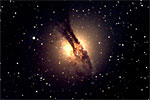
Chess and Astronomy
Global Rent-a-Scope (GRAS) is a global network of remotely operated telescope
systems. Subscribers connect to any of the available worldwide locations and
take their own images. This publicly accessible time rental service is available
through any Internet connection, including dial-up. The initial startup service
began operations in 2001.
On September 6th, 2010, at 1 pm CDT (18:00 UTC/GMT/Zulu – check the time
for your location here)
you can join Dr Marleen Bryan for a unique interview with Dr Christian Sasse,
a GRAS affiliate, and Dr John Nunn, chess grandmaster and amateur astronomer.
The interview will discuss some interesting concepts and similarities between
astronomy and the game of chess. Don't miss this live interview! Log in to the
AFM chat to ask your questions and make comments during the discussion.
For those who missed the webcast it is archived
here. |

51-year old Christian Sasse is general manager of an electrical engineering
company, an avid amateur astronomer and of course a chess player. He is the
owner of three telescopes which form part of the Global
Rent-a-Scope network, which is a system whereby amateur astronomers can
rent time on telescopes in various places around the world. These telescopes
can be controlled via the Internet and, after the images have been taken, they
can be downloaded and processed by the user. Christian generously offered GMs
John Nunn and Vishy Anand time on the GRAS telescopes.

John Nunn in his office in England, operating a remote telescopes in Mayhill,
New Mexico (United States) and in Moorook in Australia
Questions for John Nunn
- John, tell us something about your chess career.
- And how did you become interested in astronomy?
- Do you have your own telescope now?
- Are many chess players interested in astronomy?
- Is there any connection between chess and astronomy?
- Can you show us some of your images?
John will present a chess puzzle to the audience. There’s a prize of
a 290 free month plan on GRAS for a lucky winner, who will be chosen at random
from the correct entries.
Recent pictures taken by John Nunn

NGC 6334 – the "Cat's Paw Nebula", so named because it resembles
a huge paw print in the heavens, islocated near the tip of the Scorpion' s tail
in Scorpius in a massive star-forming region. It is about 5,500 light-years
from our Solar System. John spent a long time getting a decent image of this.
Quite a large object, about half a degree across. Very red. [Click
to enlarge]

The Crescent Nebula (NGC 6888 in Cygnus) is a bubble about 25 light-years across
carved by the powerful flow of material from the central Wolf-Rayet star. It’s
about 5,000 light-years away. John says he likes this picture because the nebula
contrasts nicely with the rich background starfield. [Click
to enlarge]

Centaurus A (NGC 5128 in Centaurus) ia an elliptical galaxy about 11 million
light-years away. It has a large dust lane across the middle, which is apparently
the result of the elliptical digesting a smaller spiral galaxy which it has
collided with. It has an active nucleus with strong radio and X-ray emissions.
[Click to enlarge]

The Snake Nebula, also known as Barnard 72, a dark nebula in the Ophiuchus
constellation, is a small S-shaped dust lane that snakes out in front of the
Milky Way star clouds. About 650 light-years away. You can see another dark
nebula to top right. [Click to enlarge]
Links





























